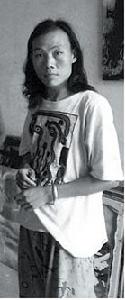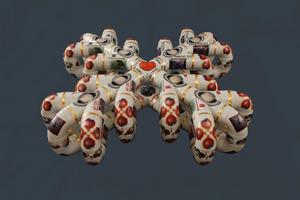 住在圓明園畫家村時的照片
住在圓明園畫家村時的照片何銳軍,字:昊遠(1964—)
1964年4月11日出生在內蒙古
1980年12月在內蒙寧城縣文化館工作(美工)
1981年在赤峰市園林管理處工作(美工)
1985年到北京開始職業藝術生涯
1987年“何銳軍抽象油畫交流展”。北京達園賓館德意志銀行中國代表處
1988年“何銳軍抽象油畫交流展”。在北京歌德學院
1988年“何銳軍抽象油畫作品展”。中國美術館藝術家畫廊
1989年8月“不同的世界—何銳軍、周吉榮、李迪、恩和藝術聯展”;北京:
1990年 “何銳軍畫展”。北京墨西哥駐中國大使館
1993年進駐圓明園畫家村
1993年“首屆中國職業畫家聯展”;北京阿芒拿畫廊
1993年“中國首屆藝術博覽會”;廣州
1993年 “圓明園藝術家村作品大聯展”;廣州
1994 張耀南、王志軍、徐子偉、老四、何銳軍合作“行者樂隊”;
1995年搬出圓明園
2009年“上海國際陶瓷博覽會”;上海
作品收藏:德國、法國、荷蘭、挪威、瑞典、丹麥、瑞士、澳大利亞、紐西蘭、墨西哥、美國、加拿大、以色列等國家機構或個人收藏
關於何昊遠
何昊遠85年就從內蒙古到北京尋求藝術發展道路,是中國最早的一批職業藝術家之一。他早期的作品探索把中國傳統藝術中的抽象因素(書法里的繪畫性和繪畫裡的書寫性)與道教虛無主義結合的抽象表現主義,作品在80年代就被眾多的國外收藏家或機構收藏。何昊遠是個迷戀於探索新文化表達形式的藝術家,離開圓明園後的十年里不斷的思考新的文化探索方式,2006年開始使用陶瓷材料製作解構主義系列作品“輪迴與報應”;試圖用現代科技觀解析和重構佛意。他認為西方現有的解構主義藝術表達方式過於依賴與立體主義和達達主義,機械的理解和偏離了解構主義哲學;在藝術表達的過程中始終身陷現代主義的泥潭而不能自拔!他認為解構藝術需要通過新視角的解析和重構來進行藝術創作,拋棄早期的立體主義和達達主義的影響,注重溝通與交流,反對現代主義的控制與壟斷,只有放棄壟斷與控制,放棄與傳統的對立,放棄任何二元對立的企圖,以更加寬容的,更自由的,更多元的方式來建構新的理論構架,才能真正發展出與解構主義哲學思想相匹配的解構主義藝術道路。
我們宇宙是一個在不斷循環系統,我們也在這個系統中處在循環狀態,何昊遠企圖用管道和圖形闡述我們這個世界在整個不斷循環的宇宙自然狀態中的現實狀態和位置,試圖站在量子力學角度下解構佛學的某種說法。他用從巨觀到微觀的圖片展現和說明我們的現實,用下水管道來隱喻物質的循環方向與過程,同時也對應了佛學所說的輪迴與報應。在構成的方式上用物質的微觀狀態來隱喻物質世界的模糊、不確定狀態。以散漫的開放姿態呈現自然可能的狀態。他的作品上沒有方向性,管道上的圖案也不分主次,撲朔迷離的效果使作品模糊、喪失二元對抗、以此表達宇宙萬物的無止休結構──解構──重構、生生滅滅的運動狀態。
關於《輪迴與報應》
切身地體驗藝術家何昊遠創作的陶瓷雕塑系列作品《輪迴與報應》,與僅僅是觀看而得的經驗是完全不同的。這種體驗與作品的結構、體積、重量、色彩所傳達的力量的質感有關。雖然理論上講,藝術與哲學是相通的,然而,以具體的視覺藝術的方式來傳達抽象的哲學思考,它挑戰的首先是藝術家以何種方式來實現這一轉換。如果不恰當地將何昊遠這一系列作品與那些機智的、觀念化的作品相比,那么也許較易於理解何昊遠作品的“重”,理解藝術家經過深思熟慮,試圖以理性地方式來“解析和重構佛學中的想法”,而這所謂“佛學中的想法”,在我看來,或許是關乎巨觀與微觀世界中生命存在的宏大命題。正因為作品本身所包涵的這一宏大企圖,它不同於西方當代藝術中常用的質詢、批判、顛覆等手法,而觀者若想以這樣的標準來評價和理解這系列作品,那么他們將無法真正地“進入”作品、了解甚至發現它們或許不同反響的意義。
藝術是人類意志的抽象,也是技術和科學之載體,純粹的學術表達產生純粹藝術效果,思想創造著實相。這一系列的每一個單件作品,看起來很像是分裂的細胞、物質的分子結構,同時也由於貼滿作品表面的來自網路的太空星系圖片、細胞分子圖片、人體結構圖片等等,這些大量而模糊的信息加強了對人類未知的巨觀以及微觀世界的暗示。作品所呈現的形狀並非真實存在,而是藝術家的想像設計。以管道、接頭、球體幾個簡單的模件,可以變化出無窮的排列組合方案。它們或許具有與當代藝術一樣的開放性、不確定性和多元性。作品結構的空間對稱,無論是開放還是封閉的狀態,都可以從任何一個角度展示和觀看它們,作品內部的緊密的互相關係卻最終導致了外部的多向性和開放性。通過這樣的方式,藝術家將他對生命存在的哲學思辯轉化為視覺藝術作品。在這系列作品中,材料、製作方式、作品結構、圖像信息、展示和接受方式共同組成了對作品意義的闡述和表達。而每一項元素背後所蘊含的文化的、哲學的信息,以及藝術家將之組合的方式,又使得作品具有了超越自身之外的沉重意味。藝術家不僅以作品,他更身體力行以堅持和執著完成他對生命存在之重的哲思。
-----------------------------------------
He Haoyaun, original name Ruijun, professional name Haoyuan. Born: 1964
April 11th 1964, born in Inner Mongolia China.
1980 - Art designer in the Museum of Culture at Ning county Inner Mongolia.
1981- Art adviser for Chifeng city’s garden maintenance.
1985 – Arrives at Beijing and begins his career as a professional artist.
1987 –“He Ruijun’s abstract oil painting”. Beijing Yuanbin Hotel.
1988 “He Ruijun’s abstract oil painting exhibition”.Beijign Goethe’s institute.
1988 “He Ruijun’s abstract oil paintins”exhibition. China’s Museum of fine arts - artists gallery.
1989 “Different Worlds – He Ruijun, Zhou jirong, Li Di,and En He Group Exhibition”. Beijing.
1990 He Ruijun’s Painting Exhibition”.Embassy of Mexico in Beijing.
1993 Moved to live in China’s famous and controversial first experimental art village ‘Yuanmingyuan’.
1993 “China’s first Professional Painting Exhibition”: Amangna Gallery, Bejing.
1993 “China’s First Art Fair Exhibition”: Guangzhou, China.
1993 “Yuanmingyuan Art Village group exhibition”: Guangzhou, China.
1994 Zhang Yaonan, Wang Zhijun, Xu Ziwei, Lao Si, and He Ruijun collaboration “The Traveling Band Exhibition: Beijing China.
1995 After the closure of the Yuanmingyuan art village moves to a residential area in Beijing.
2009 “The Shanghai Porcelain Art fair”; Shanghai, China.
He Haoyuan’s art works have been collected by institutions and art collectors all over the world, including Germany, France, Holland, Norway, Sweden, Denemark, Switzerland, Australia, New-Zealand, Mexico, U.S.A.,Canada,and Israel.
About He Haoyuan:
In 1985 at the age of 21 He Haoyuan moved from his birth place in Inner Mongolia to the more artistically vibrant capital of Beijing in a quest to pursue an art career.It was in this new context and setting that he soon became part of a small group of China’s first Avant-Garde professional artists. His early paintings explored the nature of abstract motifs in traditional Chinese art, focusing on calligraphic elements in painting where he tried to fuse Daoist nihilism with the central concepts of Western Abstract expressionism. Many of his works done through the 1980’s were collected by foreign institutions and private collectors. He Haoyuan is first and for all an artist that is Obsessed with exploring cultural modes of expression,a task he was continuously engaged with in the ten years after he left the Yuanmingyuan art village. In 2006 he began to use porcelain as the main medium for his deconstructionist series “transmigration and Retribution” where he strives to reconstruct Buddhism through the contemporary lens of advanced science. Through this medium and a new form of artistic expression he criticizes the overreliance of Western deconstructionists on cubism and their departure from the original philosophy of deconstructionism. For him these artists are constantly “falling sinking into the quicksand of modernism, unable to save themselves from their own predicament”. It’s for this reason that he thinks that Deconstructionism needs to approach matters from a new and fresh angle – in a way he is asking us to “deconstruct the deconstructionists” and move away from the early influence of Cubism to a new artistic disposition which emphasizes cultural interaction and dialogue. In order to oppose the monopoly of modernism as it strives to form rigid binaries He Haoyuan offers a more flexible, free-spirited, and diverse method where he constructs a new theoretical framework for modern art.
Our universe is a system that is forever in a state of cyclical emergence and as humans we are embedded in this system. He Haoyuan expresses this cosmological state of affairs through the use of porcelain-made water pipes and images as he tries to reconstruct the Buddhist world view from the perspective of particle physics. The images he uses to represent this complex reality are an interplay between macrocosmic and microcosmic elements in physical existence while the water pipes as “channels of water”with a hollow core are used as a metaphor for the motion and cyclicality of reality. This idea parallels the Buddhist idea of Samsara & Karma hence the name “Transmigration and Retribution”. Through this unique way of constructing his art He Haoyuan strives to express the ambiguity, uncertainty and “fussiness” of reality as he highlights and magnifies the most infinitely microscopic details of material reality. It sometimes seems like his works have no explicit direction, the images on the water pipes, for instance, do not seem to have a coherent pattern. This lends his works the complicated and somewhat confusing nature which we encounter in the chaotic and never ceasing process of the cosmos, a cosmos that never stops to construct and reconstruct itself.
About Transmigration & Retribution:
Experiencing the porcelain sculptures in He Haoyuan’s Transmigration & Retribution series is quite a unique experience. This is directly related to the work’s powerful and imposing shapes, size, weight, and vivid colors. Although theoretically speaking He Haoyuan sees art and philosophy as fields with similar goals it is clear that expressing and transmitting abstract philosophical concepts using art is his greatest challenge. Therefore his works try to offer us a glimpse at the interaction between the micro and the macro in a quest to answer life’s “big questions” and it is exactly for this reason, namely, that the works try to direct us toward ultimate concerns and big questions that they are different than Western art’s methods of seeking interpretation or criticizing. It is for this reason that looking at the works in “Transmigration & Retribution” from a Western angle will lead people to miss the point in He Haoyuan’s art. This is for the simple reason that it seeks to transmit its ideas through a method of analogy: Instead of speaking ‘explicitly’ looking at the details of the works one, almost intuitively, is drawn to the macrocosmic and universal.
In He Haoyuan’s eyes art is the abstraction of human will as well as the carriage of technique and science. Human thought on the other hand is the creator of what Buddhists refer to as Ultimate Reality or Buddha Nature. Each piece in this series looks like a structure of cells, particles, DNA or other physical structures we are familiar with. The diverse number of random images of star systems, atoms, human figures which were downloaded from the endless virtual space we have available on the internet, work to intensify the dialectical interaction between the small and the big, microcosmic and cosmic. It is interesting that the shapes of these huge porcelain structures cannot be seen in reality, they are all shapes invented by the artist through different combinations of normal and highly available water pipes that we are all familiar with. But yet they strike us as familiar and real as they adhere to the basic rules of symmetry and universal beauty. These unique configurations result in shapes which have a very modern and contemporary “feel” full of dynamism, vitality, and diversity. The works convey a built-in symmetry which conveys completeness and perfection, the type of shapes that anyone can relate to. There is an interaction between the inner elements, namely, the details on the work, the relationship between the different angles and the outer elements, namely, the overall work as it is captures by the viewer. This special dynamic is the way the artist successfully transforms his philosophical credo into visual information in the world of art. The materials, structure of the works, the process of creation, and the information transmitted through the images are all come together to convey a philosophy and a mode of religious thought. Every element and detail have a cultural baggage behind them which reflect what He Haoyuans sees as his life mission and ultimate creative goal of transmitting charges philosophy in a new language of aesthetics.
 輪迴與報應系列8
輪迴與報應系列8